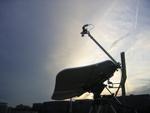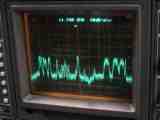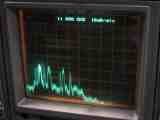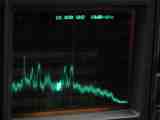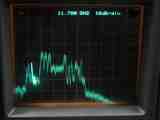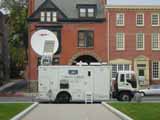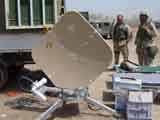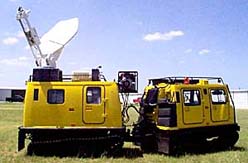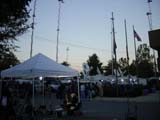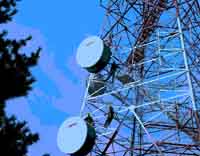Ok, so
what is SNG?
Simply
put, SNG means "Satellite News Gathering," or, using satellites
to facilitate live television pictures.
Big
deal. I see
live field reporters every day on the local news. How's this
different?
First,
you have to understand a little about radio waves.
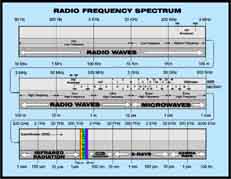 |
All radio energy travels in waves, and is
measured in Hertz (Hz), meaning cycles per second. This is where radio "wave" comes
from. The chart on the left shows all forms of electromagnetic
radiation, of which radio is a part. Longer waves are on the
left, shorter waves on the right. AM broadcast radio has about 1
million cycles per second. (1 MHz) Each cycle is almost 300
meters apart. FM radio, sitting around 100 MHz, is much shorter,
around 3 meters between waves. Mobile satellite uplinks work at
14,000 MHz, only 2 centimeters between waves! Radio waves that
high in frequency are called microwaves, and travel in straight
lines only. |
| When you see live shots on the local news,
they are using a technology called Terrestrial microwave
communication. The vehicle that does these live shots has a tall
mast that extends from the roof, sometimes up to 70 feet high (above
left). On the top of this mast is a parabolic dish antenna
(right) that directs microwaves toward a receive site (above
right). These microwaves are around 2 GHz, very close to the
microwaves that cook food in a microwave oven. The receive sites
are mounted on the TV station's tower, or other tall locations.
The drawing directly above shows how terrestrial microwave works.
As long as there is a clear "line of sight" between the two antennas,
the system will work. If there is any tall hills or buildings
between the antennas, the link will not work. Even if there is
completely clear sight between antennas, the curvature of the earth
(below) becomes a limiting factor. If the antenna is raised
higher, it can "see" farther, just like you can see miles away from a
mountain top. |
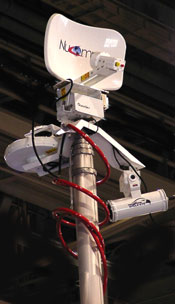 |
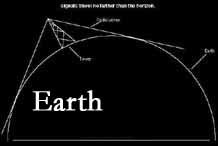 |
So, while this system works great for local
communication, it won't do much good in order to communicate over large
distances. As mentioned above, the higher the antennas are, the
further the radio horizon is. By placing a relay station on
a mountain top, the range of communications can be extended
(below). |
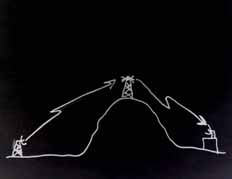 |
By placing a relay station up high on a
hill, overall range of the system is extended. On the right,
there is a coverage map of a typical repeater. Strong signals are
close to the X in the center, but terrain between the X and other
location can effect signal strength. That's why a station on a
hill 20 miles away will have a better signal than one in a valley 5
miles away. But... You only can go so high. This is where
satellites come in. |
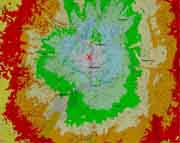 |
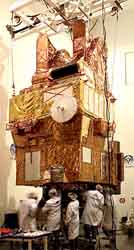 |
The view from 22,000 miles above the Earth
lets the satellite relay see an entire continent. Unlike the
coverage map above for the hilltop repeater which covers Washington DC
and its suburbs, the satellite's coverage map includes all the USA, and
most of Canada and Mexico. Special spot beams are directed out
towards Hawaii. Since the angle between transmitter and receiver
is much higher in the satellite example, there is much less chance of
buildings or hills blocking the signal. |
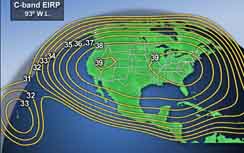 |
Now I am less confused... I think. How do you find a tiny
satellite 22,000 miles up?
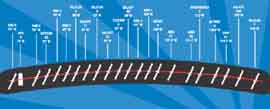 |
Thankfully, all the
communications satellite stay "parked" in the same place in the sky,
right above the equator. This is called a geosynchronous orbit,
meaning the satellite moves at the same speed at the Earth's rotation,
making it appear in the same place all the time. Other orbits
include asynchronous, which includes low orbit satellites such as the
space shuttle. These orbits are only a few hundred miles
up. Polar orbits stay fixed in space as the Earth rotates
below. The chart on the left shows the North American arc of
Ku-band satellites. Uplink operators know what part of the sky
they need to start searching to find a satellite. |
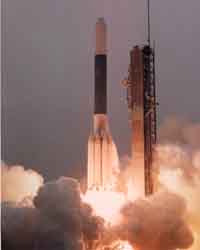 |
Satellites are pushed into
orbit via rockets, often launched from areas close to the
equator. The vehicle on the left is a Delta. Rockets
launched from the equator need less fuel to get their payload into
geosync orbit. That orbit is about 88 times higher than the space
shuttle typically goes, and it requires a rocket with lots of
fuel. Equatorial launches get a boost from the Earth's
rotation. Since the Earth is moving through space fastest on the
equator, the boost effect is greatest there. Once a satellite is
in orbit, it has enough fuel to remain for around 10-12 years.
Later in its life, it can't keep a steady orbit and becomes
inclined. Once they get too sloppy, they can either be deorbited
like MIR, or moved to a high "graveyard" orbit, which is more common
among the high geosync sats. Satellites in the arc are spaced 2
degrees apart at their closest. This means that a dish movement
of a few inches can mean having or not having the signal. Once
one satellite is identified, it orients the operator and they can then
go easily anywhere else in the arc. The most stressful part of a
SNG operator's day can be quickly "finding a bird" during a breaking
news story. A good operator can find the correct satellite in
about 5 minutes. |
How do you identify a satellite?
| You have to look at its nametag!
Well, sort of. Each satellite has a unique pattern when its
signals are viewed on a spectrum monitor, or THE SCOPE as its called by
SNG ops. This little piece of equipment is at the heart of any
uplink operation. Without it, it is practically impossible to
find and identify satellites. As the dish tracks across the sky
(looking where the sats should be) signals will suddenly appear on the
scope. They don't always jump right out; often it is just a small
indication meaning the dish has to be fine tuned by moving the
elevation (up/down) and azimuth (east/west) slightly. |
Full 500MHz span view
SBS-6
GE-5
Telstar-4
Telstar-6
SBS-6 has a very identifiable pattern, once zoomed in.

What do sat trucks look like? Where do they come from?
| Uplinks can be built on several platforms,
including vans, trucks, and portable units. They have been built in
busses, and ATV's too! They are built by several "intergrators" around
the country, including Wolf Coach, Frontline,
and Shook.
Although they may share a common design, each one is unique. For sat
trucks, they start with a bare truck frame, and build from the ground
up. Building trucks requires a lot of custom fabrication, and about 6
months to complete. New trucks can cost between $500,000 and
$1,000,000, depending on what's inside. |
|
 About SNG
About SNG